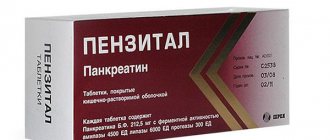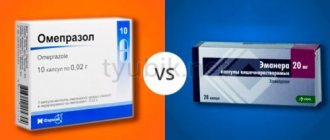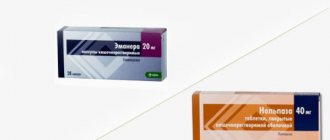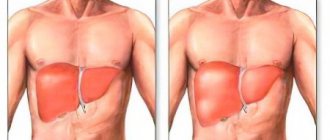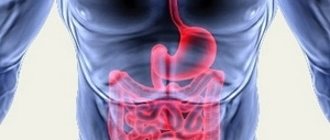Emanera
Emanera ®
(lat.
Emanera
®) - antiulcer drug, proton pump inhibitor (PPI).
Composition of Emanera
Emanera is available in the form of enteric-coated capsules, 20 mg and 40 mg. The active substance of Emanera is esomeprazole. One capsule of Emanera contains:
- active substance: 20.645 mg or 41.29 mg esomeprazole magnesium, corresponding to 20 mg and 40 mg esomeprazole
- excipients (including pellet shell and capsule substance): granulated sugar (contains sucrose and starch molasses), povidone K30, sodium lauryl sulfate, Opadry II white 85F28751 (polyvinyl alcohol, titanium dioxide (E171)*, macrogol 3000, talc), magnesium carbonate heavy, methacrylic acid and ethyl acrylate copolymer (1:1), dispersion 30% Eudragit L30D, talc, macrogol 6000, red iron oxide dye (E172), gelatin.
Indications for use of Emanera
Gastroesophageal reflux disease (GERD):
- treatment of erosive reflux esophagitis
- long-term maintenance treatment after healing of erosive reflux esophagitis to prevent relapse
- symptomatic treatment of GERD
Peptic ulcer of the stomach and duodenum: As part of combination therapy (monotherapy with Emanera is not used for HP eradication):
- treatment of gastric and duodenal ulcers associated with Helicobacter pylori
(Hp) - prevention of relapses of peptic ulcer disease associated with Hp
With long-term use of non-steroidal anti-inflammatory drugs (NSAIDs):
- healing of stomach ulcers associated with taking NSAIDs
- prevention of gastric and duodenal ulcers associated with taking NSAIDs in patients at risk
Zollinger-Ellison syndrome
or other conditions characterized by pathological hypersecretion, including idiopathic hypersecretion.
Method of administration of Emanera and dose
The Emanera capsule is swallowed whole with liquid.
The capsules are not chewed or crushed. If you have problems swallowing, the capsule is dissolved until it disintegrates into microgranules in 100 ml of still water, after which all microgranules are drunk immediately or within half an hour, then another 100 ml of still water is added, the remainder is stirred and drunk. GERD
- one or two courses (the second - if the first is not enough to heal or get rid of the symptoms of esophagitis), each for 40 days, 40 mg of Emanera once a day
- maintenance therapy after healing of esophagitis - 20 mg Emanera once a day for a long period
- symptomatic treatment of GERD without esophagitis - 20 mg Emanera once a day; symptoms should disappear within 4 weeks
Stomach and duodenal ulcers (adults only)
- treatment of duodenal ulcers or prevention of peptic ulcers associated with Helicobacter pylori
- twice a day: Emanera 20 mg, amoxicillin 1 g and clarithromycin 500 mg for a week;
it is possible to use Emanera as part of other eradication regimens ( see “Standards for diagnosis and treatment of acid-dependent and Helicobacter pylori-associated diseases (4th Moscow agreement)”
). - Treatment of stomach ulcers associated with NSAIDs: Emanera 20 mg or 40 mg once daily for 4-8 weeks
- prevention of gastric and duodenal ulcers associated with NSAIDs: Emanera 20 mg or 40 mg once a day
Conditions associated with pathological hypersecretion (adults only)
, including Zollinger-Ellison syndrome and idiopathic hypersecretion. The starting dose is 40 mg Emanera twice a day. Next, the dose is selected individually, the duration of treatment depends on the development of the disease.
Pharmacological properties of Emanera
The pharmacokinetics and pharmacodynamics of Emanera are determined by the active substance and are described in the article esomeprazole in the sections pharmacokinetics of esomeprazole
and
pharmacodynamics of esomeprazole
.
Contraindications to Emanera therapy
- hypersensitivity to esomeprazole, substituted benzimidazoles or other ingredients included in the drug
- hereditary fructose intolerance, glucose-galactose malabsorption or sucrase-isomaltase deficiency
- Emanera should not be taken with atazanavir
- with caution in severe renal failure
Use of Emanera during pregnancy and breastfeeding
During pregnancy, Emanera therapy is possible only for health reasons.
When taking Emanera, you must stop breastfeeding. The FDA category of risk for the fetus when using Emanera in a pregnant woman is B (animal studies have not revealed the risk of negative effects on the fetus; there have been no adequate studies in pregnant women).
Side effects of Emanera
Headache, abdominal pain, diarrhea, flatulence, nausea, vomiting, constipation, dermatitis, itching, urticaria, rash, dizziness, dry mouth, insomnia, paresthesia, drowsiness, increased activity of liver enzymes, peripheral edema.
Long-term or high-dose use of Emanera increases the risk of hip, wrist, and spine fractures (“FDA Warns”).
Overdose of Emanera
Taking Emanera at a dose of 280 mg is accompanied by general weakness and symptoms from the gastrointestinal tract. A single dose of 80 mg of Emanera does not cause any negative effects. Specific antidotes are unknown. Esomeprazole binds to plasma proteins, making dialysis ineffective. In case of overdose, symptomatic and general supportive treatment is provided.
Special instructions for Emanera therapy
If any alarming symptoms are present (for example, significant spontaneous weight loss, repeated vomiting, dysphagia, hematemesis, or melena), or if a gastric ulcer is present or suspected, the presence of a malignant neoplasm should be excluded, since treatment with Emanera may lead to flattening symptoms and delay diagnosis.
Those taking Emanera for a long period (especially more than a year) should be under regular medical supervision. Those taking Emanera "as needed" should be instructed to contact their physician if their symptoms change. Since there are fluctuations in the concentration of esomeprazole in plasma when prescribing therapy “as needed”, it is necessary to take into account the interaction of the drug with other drugs. Clarithromycin is a potent inhibitor of cytochrome CYP3A4, therefore, when prescribing eradication therapy to patients receiving other drugs metabolized by CYP3A4 (for example, cisapride), possible contraindications and interactions of clarithromycin with these drugs must be taken into account. Emanera contains sucrose and is therefore contraindicated in patients with hereditary fructose intolerance, glucose-galactose malabsorption or sucrase-isomaltase deficiency.
Interaction of Emanera with other drugs
The interaction of Emanera with other drugs is determined by its active substance and is described in the article esomeprazole, in the section interaction of esomeprazole with other drugs
.
If it is necessary to simultaneously take proton pump inhibitors (including Emanera) and clopidogrel, instead of Emanera, the American Heart Association recommends taking pantoprazole (Bordin D.S.).
Professional medical publications regarding the use of Emanera in the treatment of gastrointestinal diseases
- Kurilovich S., Chekalina E., Belkovets A., Shcherbakova L. Antisecretory activity of esomeprazole (Emanera ®) in patients with acid-dependent diseases // Doctor. 2015. No. 8. pp. 35–40.
- Kurilovich S.A., Chekalina E.A., Belkovets A.V., Shcherbakova L.V. Dose-dependent antisecretory activity of esomeprazole: results of long-term monitoring of intragastric pH // RZHGGK. – 2016. – No. 3. pp. 33-40.
- Evsyutina Yu.V. The effectiveness of esomeprazole in the treatment of patients with gastroesophageal reflux disease // RZHGGK. 2022. No. 27(1). pp. 44–49.
On the website GastroScan.ru in the “Literature” section there is a subsection “Esomeprazole”, containing professional medical articles concerning the treatment of diseases of the gastrointestinal tract with drugs whose active ingredient is esomeprazole, including Emanera.
Medicines containing the active ingredient esomeprazole
In addition to Emanera, the following drugs with the active substance esomeprazole are registered in Russia: Nexium, Neo-Zext, Esomeprazole-Vial, Esomeprazole Zentiva, Esomeprazole Canon, Esomeprazole-native, Emezol.
In some other countries, brands are registered and produced: Nexium and Nexium IV (USA), Esopral (Italy, the Netherlands), Axagon (Italy), Nexiam (Belgium, Luxembourg, South Africa), as well as generics of esomeprazole: Sompraz (India, Myanmar), Neksium and Neksium Inj (India), Nexpro (India), Ezokar (Belarus, Palestine), etc.
general information
The manufacturer of Emanera is KRKA (KRKA, dd), Slovenia.
Instructions for medical use of the drug Emanera (enteric capsules, 20 and 40 mg), approved by the Ministry of Health of Russia on 10/12/17 (pdf)
Emanera does not affect the ability to drive a car or operate machinery.
According to the pharmacological index, Emanera belongs to the group “Proton pump inhibitors”. According to ATC, it belongs to the group “Proton pump inhibitors” and has the code A02BC05.
* In the EU, from 2022, by decision of the European Food Safety Authority (EFSA), the use of titanium dioxide (E171) in food is completely prohibited, as this food additive is no longer considered safe.
Emanera has contraindications, side effects and application features; consultation with a specialist is necessary.
Back to section
Emanera®
Effect of esomeprazole on the pharmacokinetics of other drugs
Drugs whose absorption depends on pH levels
A decrease in the secretion of hydrochloric acid in the stomach during treatment with esomeprazole and other PPIs can lead to changes in the absorption of drugs, the absorption of which depends on the level of acidity of the environment. Like antacids and other drugs that reduce gastric acidity, esomeprazole may reduce the absorption of ketoconazole, itraconazole and erlotinib.
and increasing the absorption of drugs such as
digoxin.
Concomitant use of omeprazole 20 mg once daily and digoxin
increases the bioavailability
of digoxin
by 10% (bioavailability
of digoxin
increased by up to 30% in two out of ten patients).
Omeprazole is known to interact with some antiviral drugs.
The mechanism and clinical significance of these interactions are not always known.
A decrease in gastric acidity during omeprazole therapy may affect the absorption of antiviral drugs.
Interaction at the level of the CYP2C19 isoenzyme is also possible.
During therapy with omeprazole, there is a decrease in the serum concentrations of some antiviral drugs (atazanavir and nelfinavir).
Therefore, simultaneous use is contraindicated.
Concomitant use of omeprazole (40 mg once daily) with atazanavir
300
mg/ritonavir
100 mg in healthy volunteers is accompanied by a marked decrease in the bioavailability of atazanavir (AUC, Cmax and minimum concentration [Cmin] in plasma decreased by approximately 75%).
Increasing the atazanavir
to 400 mg did not compensate for the effect of omeprazole on the bioavailability
of atazanavir.
When omeprazole is used concomitantly with saquinavir
of saquinavir
increases .
Given the similar pharmacokinetic and pharmacodynamic properties of omeprazole and esomeprazole, the simultaneous use of esomeprazole with antiviral drugs such as atazanavir and nelfinavir,
contraindicated.
Drugs metabolized by the
CYP2C19 isoenzyme
CYP2C19 of esomeprazole metabolism. Thus, with simultaneous use of esomeprazole with drugs whose metabolism involves the CYP2C19 isoenzyme, such as diazepam, citalopram, imipramine, clomipramine, phenytoin
etc., the concentration of these drugs in the blood plasma may increase and, accordingly, a reduction in their dose may be required.
This especially needs to be taken into account when prescribing Emanera® in the on-demand mode. Thus, when used simultaneously with 30 mg of esomeprazole, the clearance of diazepam
(CYP2C19 isoenzyme substrate) by 45%.
Concomitant use of esomeprazole at a dose of 40 mg leads to an increase in phenytoin
in the blood plasma of patients with epilepsy by 13%. It is recommended to monitor plasma concentrations of phenytoin when initiating esomeprazole therapy and when discontinuing it.
When using omeprazole at a dose of 40 mg, the Cmax and AUC of voriconazole
(CYP2C19 isoenzyme substrate) by 15% and 41%, respectively.
Coagulation time with simultaneous long-term use of warfarin
and esomeprazole at a dose of 40 mg remains within acceptable limits.
However, a few cases of clinically significant increases in the international normalized ratio (INR) have been reported. It is recommended to monitor the INR at the beginning and at the end of concomitant use of esomeprazole and warfarin or other coumarin derivatives.
The use of omeprazole at a dose of 40 mg led to an increase in Cmax and AUC of cilostazol
by 18% and 26%, respectively; for one of the active metabolites
of cilostazol
, the increase was 29% and 69%, respectively.
Concomitant use of esomeprazole 40 mg with cisapride
leads to an increase in the values of the pharmacokinetic parameters of cisapride in healthy volunteers: AUC - by 32% and T1/2 - by 31%, but Cmax does not change significantly. The slight prolongation of the QT interval on the ECG, which is observed with cisapride monotherapy, was not increased by the addition of esomeprazole.
Some patients experienced increased concentrations of methotrexate
in blood serum during simultaneous use with PPIs. When using high doses of methotrexate, the possibility of temporary withdrawal of esomeprazole should be considered.
Esomeprazole does not cause clinically significant changes in the pharmacokinetics of amoxicillin and quinidine.
Concomitant short-term use of esomeprazole and naproxen or rofecoxib
did not reveal a clinically significant pharmacokinetic interaction. Results obtained from studies in healthy volunteers demonstrated a pharmacokinetic/pharmacodynamic interaction between clopidogrel (loading dose 300 mg/maintenance dose 75 mg per day) and esomeprazole (40 mg per day when administered orally), which leads to a decrease in systemic exposure of the active metabolite clopidogrel by an average of 40% and a decrease in the maximum suppression of (ADP-induced) platelet aggregation by an average of 14%.
When clopidogrel was used simultaneously with a fixed combination of 20 mg esomeprazole/81 mg acetylsalicylic acid (ASA), compared with the use of clopidogrel alone, in a study involving healthy volunteers, a decrease in systemic exposure to the active metabolite of clopidogrel was observed by almost 40%. However, the maximum levels of inhibition of (ADP-induced) platelet aggregation in these healthy volunteers were similar in the clopidogrel and clopidogrel fixed combination (esomeprazole/ASA) groups.
Both observational and clinical studies have provided conflicting data regarding the clinical consequences of the pharmacokinetic/pharmacodynamic interaction of esomeprazole on major cardiovascular events. As a precaution, concomitant use of clopidogrel should be avoided.
When used simultaneously with tacrolimus
increased serum concentrations
of tacrolimus are possible.
Effect of drugs on the pharmacokinetics of esomeprazole
The isoenzymes CYP2C19 and CYP3A4 are involved in the metabolism of esomeprazole.
With simultaneous use of esomeprazole with clarithromycin (500 mg 2 times a day) (inhibitor of the CYP3A4 isoenzyme), the AUC value of esomeprazole increases by 2 times.
Concomitant use of esomeprazole and a combined inhibitor of CYP2C19 and CYP3A4 isoenzymes (for example, voriconazole)
may be accompanied by an increase in the AUC of esomeprazole by more than 2 times. Usually in such situations no change in the dose of esomeprazole is required. In patients with severely impaired liver function or if long-term therapy is necessary, the issue of reducing the dose of esomeprazole should be considered.
Drugs that induce CYP2C19 and CYP3A4 isoenzymes, such as rifampicin and St. John's wort preparations, when used simultaneously with esomeprazole, may lead to a decrease in the concentration of esomeprazole in the blood plasma by accelerating the metabolism of esomeprazole.
Emanera enteric capsules 20 mg 14 pcs. in Taganrog
Inside,
without chewing, with a small amount of liquid.
For patients with difficulty swallowing, pour the contents of the capsules into half a glass of still water, stir and drink immediately or within 30 minutes. Then fill the glass halfway with water, rinse the sides of the glass and drink.
The drug should not be mixed with other liquids, because this may lead to the dissolution of the pellet's protective coating. Pellets should not be chewed or crushed.
For patients who are unable to swallow on their own, the contents of the capsules should be dissolved in still water and esomeprazole administered through a nasogastric tube. It is necessary to check the compliance of the syringe for administering the drug and the probe. Instructions for preparing and administering the drug through a nasogastric tube are given in the subsection “Administration of the drug through a nasogastric tube.”
Adults and teenagers over 12 years old
GERD:
— Erosive reflux esophagitis (treatment): 40 mg once a day for 4 weeks. If, after the first course of therapy, healing of esophagitis does not occur or symptoms persist, an additional 4-week course of treatment with esomeprazole is recommended.
— Long-term maintenance treatment after healing of erosive reflux esophagitis to prevent relapse: 20 mg 1 time per day.
— Symptomatic treatment of GERD: 20 mg 1 time per day — for patients without esophagitis. If after 4 weeks of therapy it is not possible to achieve control of symptoms, it is necessary to re-examine the patient. After symptoms have resolved, you can continue taking Emanera as required, i.e. take 20 mg of the drug once a day if symptoms occur. For patients taking NSAIDs at risk of developing gastric or duodenal ulcers, on-demand treatment is not recommended.
Adult patients
Peptic ulcer of the stomach and duodenum
As part of combined antibacterial therapy for the eradication of Helicobacter pylori:
— Duodenal ulcer associated with Helicobacter pylori
and prevention of relapses of peptic ulcers associated with
Helicobacter pylori
(combined eradication therapy for
Helicobacter pylori
includes: Emanera 20 mg, amoxicillin 1 g and clarithromycin 500 mg). All medications are taken 2 times a day for 7–14 days.
Patients taking NSAIDs for a long time:
— Healing of stomach ulcers associated with taking NSAIDs: 20 mg or 40 mg once a day for 4–8 weeks.
— Prevention of gastric and duodenal ulcers associated with taking NSAIDs in patients at risk: Emanera 20 mg or 40 mg once a day.
Long-term prevention of recurrent bleeding from peptic ulcers (after intravenous use of drugs that reduce the secretion of gastric glands): Emanera 40 mg once a day for 4 weeks after starting intravenous prevention of recurrent bleeding.
Zollinger-Ellison syndrome and other conditions characterized by increased gastric secretion, incl. idiopathic hypersecretion: the initial dose of Emanera is 40 mg 2 times a day. The dose of the drug and duration of treatment are selected individually depending on the clinical picture of the disease. The disease in most patients is controlled by taking the drug at a dose of 80 to 160 mg/day. If it is necessary to use the drug Emanera over 80 mg/day, the daily dose is divided into two doses.
Renal dysfunction.
Patients with impaired renal function do not require dose changes. Experience with esomeprazole in patients with severe renal impairment is limited; therefore, caution should be exercised when prescribing the drug to such patients.
Liver dysfunction. Patients with mild or moderate liver dysfunction do not require dose changes. In severe liver failure, the maximum daily dose should not exceed 20 mg.
Elderly patients.
Elderly patients do not require dose adjustment.
Administration of the drug through a nasogastric tube
When prescribing the drug through a nasogastric tube, you must:
1. Open the capsule and pour the contents of the capsule into a special syringe. Add 25 ml of drinking water and approximately 5 ml of air to the syringe. For some probes, it may be necessary to dilute the drug in 50 ml of drinking water in order to prevent clogging of the probe with pellets contained in the capsule.
2. After adding water, immediately shake the syringe until a suspension is obtained.
3. Make sure that the tip is not clogged (pressing the plunger slightly while holding the syringe in the tip-up position).
4. Insert the tip of the syringe into the probe, continuing to keep it pointed upward.
5. Shake the syringe and turn it upside down. Immediately inject 5–10 ml of the dissolved drug into the probe. After injecting the solution, return the syringe to its previous position and shake (the syringe should be held with the tip up to avoid clogging of the tip).
6. Lower the syringe again with the tip down and inject another 5–10 ml of solution into the probe. Repeat the procedure until the syringe is empty.
7. If part of the drug remains as sediment in the syringe: fill the syringe with 25 ml of water and 5 ml of air and repeat the procedures described in points 5 and 6. For some probes, 50 ml of drinking water may be needed for this purpose.

